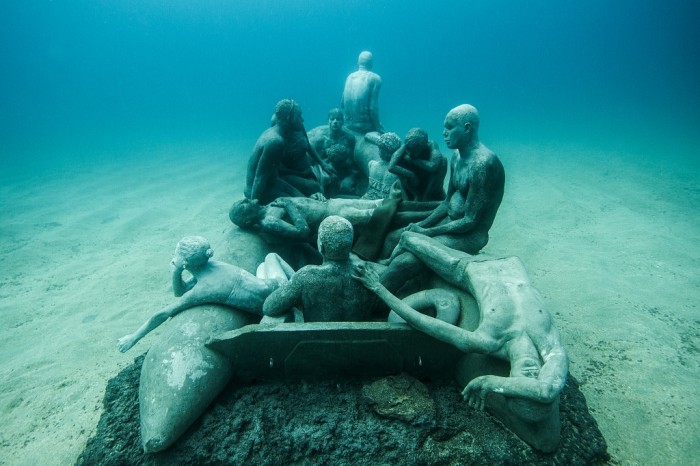Scientists believe that the permanent destruction of the world’s natural coral reefs will happen by the year 2050. Although they are present in shallow seas, coral reefs are home to a vast majority of marine life. These diverse underwater ecosystems are vulnerable to extreme weather, climate change, and man-made threats such as; pollution, overfishing, destructive fishing practices using dynamite or cyanide, collecting live corals for the aquarium market and the mining of coral for building materials. To draw attention to the decline of these beautiful structures, Jason deCaires Taylor, a sculptor, created a series of sculptural installations that inhabit the ocean floor.
Around 14 metres beneath the Atlantic Ocean, Taylor’s latest works, The Museo Atlantico, is comprised of two separate installations called The Rubicon and The Raft of Lampedusa. Situated off the coast of the Lanzarote Island in Spain, these hyperrealistic sculptures speak to the refugee crisis in Europe while promoting coral growth.
According to Taylor’s web page, his sculptures are a synthesis of art and science. The sculptor works with marine biologists to create habitat spaces designed to encourage specific forms of marine life. His sculptures are made with carefully researched, environmentally-friendly materials which actively promote coral growth, and inert Ph neutral properties designed to last hundreds of years.
“In The Anthropocene (2011), a life-size replica of the classic Volkswagen Beetle encloses a “Lobster City”, designed to attract crustaceans. Inercia (2011) depicts a man on a couch watching television, ignorant of our environmental crisis; yet the television provides a habitat space for juvenile fish,” reads his web page.
The Museo Atlantico tackles a humanitarian issue, the influx of millions of Syrian refugees fleeing ongoing conflict in their home country. The Raft of Lampedusa is a depiction of desperate refugees on a boat as they wait for treatment and aid.
Speaking to My Modern Met, Taylor said, “The work is not intended as a tribute or memorial to the many lives lost, but as a stark reminder of the collective responsibility of our now global community.”
The second installation, The Rubicon, depicts an assembly of 35 people walking towards a gate. Visibly oblivious, a number of the figures are staring at their electronic devices as they shuffle into the unknown.











